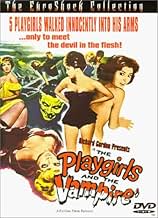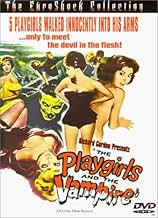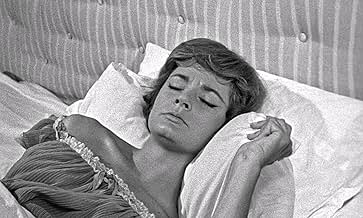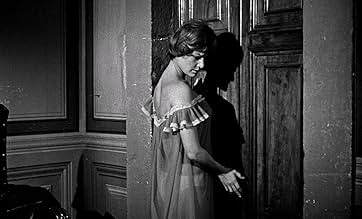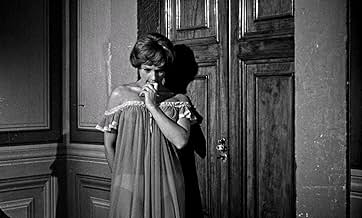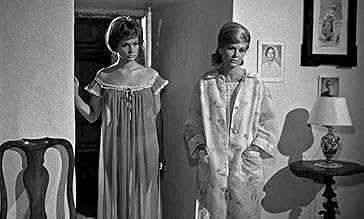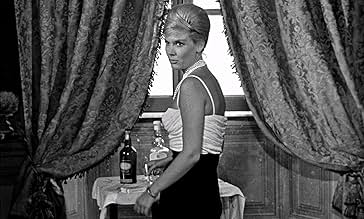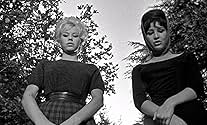NOTE IMDb
5,1/10
689
MA NOTE
Ajouter une intrigue dans votre langueFive beautiful showgirls are trapped by a storm and find refuge in a creepy old castle. The owner of the castle, a strange nobleman, has a secret laboratory in the basement and has his own p... Tout lireFive beautiful showgirls are trapped by a storm and find refuge in a creepy old castle. The owner of the castle, a strange nobleman, has a secret laboratory in the basement and has his own plans for the girls.Five beautiful showgirls are trapped by a storm and find refuge in a creepy old castle. The owner of the castle, a strange nobleman, has a secret laboratory in the basement and has his own plans for the girls.
- Réalisation
- Scénario
- Casting principal
Avis à la une
Five female dancers, their manager and their bus driver travel around Europe performing in one venue after another while barely making ends meet. One night after a storm blocks the main road, they take a secondary route which leads to a castle belonging to "Count Gabor Kernassy" (Walter Brandi). They are warned to turn around but are reluctant to do so because the manager "Lucas" (Alfredo Rizzo) didn't pay the hotel bill the night before. So the Count puts them up for the night but gives them a strict warning that they are not to leave their bedrooms during the night. Unfortunately, one curious dancer named "Katia" (Maria Giovannini) becomes too curious and dies from an apparent fall from the castle. Things only begin to get even more curious after that. That said, rather than divulge the mysteries that remain I will just say that this is a film more noted for the attractive dancers than anything else. And while Maria Giovannini was certainly sexy, I thought Lyla Rocco (as "Vera") was prettier still. But other than the appearance of the attractive ladies, I thought the film was slow-moving and dull at times. Still, it wasn't a bad vampire film and it's worth a look for those who enjoy movies of this kind from the early 60's.
PLAYGIRLS AND THE VAMPIRE is a so-so early Italian horror movie that is good enough to hold an average euro-horror film buffs attention. Nice music, great looking (and occasionally, scantilly clad) go-go dancers, and not to mention an oddly unique final death scene.
Overall, a nice addition to any obscure movie collection, that will probably merit more than one viewing.
Overall, a nice addition to any obscure movie collection, that will probably merit more than one viewing.
Ragnoli's film focuses on the travails of a group of five dance hall girls and their manager who, after defaulting on a hotel bill, find themselves bumping through unfamiliar countryside at night looking for late accommodation. Ignoring the warnings of a local, they continue along a side road to the castle of a mysterious Count Kernassy (Walter Brandi), where one of the girls, Vera experiences strong feelings of déjà vu. At first treated with coldness, it soon appears that the beautiful-yet-mopey Vera bears a startling resemblance to one of Count Kernassy's ancestors, Margherita. Ominously, the Count has an infatuation with this long-dead beauty. As sudden storms wash out bridges behind them, the troupe are obliged to spend more than one night at the castle and, despite warnings, venture out of the their rooms at night...
A minor camp item with some historical interest today, The Playgirls And The Vampire first saw light of day on the continent as L'ultima preda del vampiro (trans: The Vampire's Final Prey), an Italian attempt to capitalise on the vogue for the contemporary Hammer product with a suitably spiced-up Euro version. Adding lashings of female titillation in a way which was unthinkable to the Anglo Saxon market (the film includes a brief topless shot), director Piero Ragnoli made up a package which was both more lascivious than that produced by the studio at Bray, and one to which critical opinion has been less kind. Predictably, the heady cocktail was a commercial success at the time, and some commentators have since seen the results as anticipating the sexy vampire cinema of Jean Rollin a few years later, although the sheen of erotic sophistication brought by the French auteur is conspicuously missing here. American producer Richard Gordon, sensing money from the exploitation market, promptly picked up the English language rights to the original film, did a rush-dubbing job and re-titled it with an eye on maximum marquee appeal. (He also prepared a cut print for those areas in which censorship was more squeamish, under the title of Curse Of The Vampire - a version that by all accounts approached the incoherent).
While the beginning of this version of the film, which features a long tracking shot from a dungeon window to a stone sarcophagus and an emerging, spidery hand, momentarily recalls some of the splendours of such films as Bava's Mask Of The Demon (aka: La Maschera del demonio, 1960), such atmospherics are rarely repeated. The most effective moment occurs during the big burial scene later, where Aldo Greci's camera performs a 360-degree pan around the faces of the mourners from a low angle. Here the combination of a daring, continuous shot, allied with the distortions of a wide-angle lens produces the sense of dread a film like this so badly needs. Elsewhere the cinematography is more careless, with at least one scene suffering from a distracting focus problem, and the sparse interiors of the Count's castle being lit without subtlety. Unfortunately, the plot hardly distracts one from such shortcomings. Containing more holes than a ghoul's winding sheet, in execution it only emphases that for the most part Ragnoli's technical competence is mediocre. Given the electric possibilities which exist when sex and horror are combined, his film rarely aspires to the erotic, even though the glamorous playgirls are frequently to be seen wandering through chilly grounds and corridors, clad in nothing but their nighties.
What makes the film enjoyable is the passing campness of it all, the ineptness of the characters and the ludicrousness of some of the dialogue. The girls form part of a truly terrible dance troupe: when, after a tragedy, they gather to lose themselves in a rehearsal ("the girls have been very upset, and this is the only way to make them stop worrying about it" we are assured) and one performs a striptease, their lack of professionalism and poise in ensemble is laughable. Their manager, Lucas, (Alfredo Rizzo) is a crabby, cynical showman who is at least a more believable stereotype than the dull vampire fodder he escorts. In one of the more amusing moments of the film, we see him snuggling down in his room with a girlie magazine before being confronted by a nude, newly dead girl. Here his mugging is entertaining and the often self-conscious dialogue, which is a feature of the film, doesn't intrude. Elsewhere the non-sequiturs can be amazing ("I just don't understand it"/ "What don't you understand?"/ "Nothing, nothing at all" is one worthy of Ed Wood). As various mysterious events unfold, such conversations contribute to an atmosphere that can be just as bewildering to the audience as to the principals. Supporting characters, such as the groundskeeper, the limping Zoltan (probably Antoine Nicos), and the housekeeper (Marisa Quattrini) remain woefully undeveloped which given the nature of the genre, where every servant is a satanic stooge it seems, is surprising. One especially regrets the waste of the housekeeper. A demonic Mrs Danvers would have been a useful bonus in taking up some of the dramatic slack.
As "one of the first horror films from any country to mix Gothic horror and explicit eroticism," the film is a slight genre landmark. Perhaps a director with a greater sense of visual style would have made more of the opportunity, but the result is still watchable, if a little slow. For those who enjoy continental horror from this time - the start of a classic production period, which until recently has been hard to see - this is worth seeking out, if not essential viewing.
A minor camp item with some historical interest today, The Playgirls And The Vampire first saw light of day on the continent as L'ultima preda del vampiro (trans: The Vampire's Final Prey), an Italian attempt to capitalise on the vogue for the contemporary Hammer product with a suitably spiced-up Euro version. Adding lashings of female titillation in a way which was unthinkable to the Anglo Saxon market (the film includes a brief topless shot), director Piero Ragnoli made up a package which was both more lascivious than that produced by the studio at Bray, and one to which critical opinion has been less kind. Predictably, the heady cocktail was a commercial success at the time, and some commentators have since seen the results as anticipating the sexy vampire cinema of Jean Rollin a few years later, although the sheen of erotic sophistication brought by the French auteur is conspicuously missing here. American producer Richard Gordon, sensing money from the exploitation market, promptly picked up the English language rights to the original film, did a rush-dubbing job and re-titled it with an eye on maximum marquee appeal. (He also prepared a cut print for those areas in which censorship was more squeamish, under the title of Curse Of The Vampire - a version that by all accounts approached the incoherent).
While the beginning of this version of the film, which features a long tracking shot from a dungeon window to a stone sarcophagus and an emerging, spidery hand, momentarily recalls some of the splendours of such films as Bava's Mask Of The Demon (aka: La Maschera del demonio, 1960), such atmospherics are rarely repeated. The most effective moment occurs during the big burial scene later, where Aldo Greci's camera performs a 360-degree pan around the faces of the mourners from a low angle. Here the combination of a daring, continuous shot, allied with the distortions of a wide-angle lens produces the sense of dread a film like this so badly needs. Elsewhere the cinematography is more careless, with at least one scene suffering from a distracting focus problem, and the sparse interiors of the Count's castle being lit without subtlety. Unfortunately, the plot hardly distracts one from such shortcomings. Containing more holes than a ghoul's winding sheet, in execution it only emphases that for the most part Ragnoli's technical competence is mediocre. Given the electric possibilities which exist when sex and horror are combined, his film rarely aspires to the erotic, even though the glamorous playgirls are frequently to be seen wandering through chilly grounds and corridors, clad in nothing but their nighties.
What makes the film enjoyable is the passing campness of it all, the ineptness of the characters and the ludicrousness of some of the dialogue. The girls form part of a truly terrible dance troupe: when, after a tragedy, they gather to lose themselves in a rehearsal ("the girls have been very upset, and this is the only way to make them stop worrying about it" we are assured) and one performs a striptease, their lack of professionalism and poise in ensemble is laughable. Their manager, Lucas, (Alfredo Rizzo) is a crabby, cynical showman who is at least a more believable stereotype than the dull vampire fodder he escorts. In one of the more amusing moments of the film, we see him snuggling down in his room with a girlie magazine before being confronted by a nude, newly dead girl. Here his mugging is entertaining and the often self-conscious dialogue, which is a feature of the film, doesn't intrude. Elsewhere the non-sequiturs can be amazing ("I just don't understand it"/ "What don't you understand?"/ "Nothing, nothing at all" is one worthy of Ed Wood). As various mysterious events unfold, such conversations contribute to an atmosphere that can be just as bewildering to the audience as to the principals. Supporting characters, such as the groundskeeper, the limping Zoltan (probably Antoine Nicos), and the housekeeper (Marisa Quattrini) remain woefully undeveloped which given the nature of the genre, where every servant is a satanic stooge it seems, is surprising. One especially regrets the waste of the housekeeper. A demonic Mrs Danvers would have been a useful bonus in taking up some of the dramatic slack.
As "one of the first horror films from any country to mix Gothic horror and explicit eroticism," the film is a slight genre landmark. Perhaps a director with a greater sense of visual style would have made more of the opportunity, but the result is still watchable, if a little slow. For those who enjoy continental horror from this time - the start of a classic production period, which until recently has been hard to see - this is worth seeking out, if not essential viewing.
The Playgirls and the Vampire is the English-language version of Piero Regnoli's L'ultima preda del vampiro, released in the US by enterprising producer and distributor Richard Gordon.
The film sees a troupe of exotic dancers, their piano player Frank (Leonardo Botta) and manager Lucas (Alfredo Rizzo) seeking refuge at a remote castle after they are forced to take a detour in their minibus. The owner of the castle, Count Gabor Kernassy (Walter Brandi), reluctantly allows the visitors to stay but neglects to tell them about the vampire that stalks the place at night...
The plot for this film is pedestrian (it's very similar to the equally desperate The Vampire and the Ballerina, released earlier the same year) and the script is uninspired, the film relying on the allure of its scantily clad women to retain the viewer's interest. The ladies are certainly attractive, but even with plenty of 'cheesecake' (and a brief glimpse of nudity), The Playgirls and the Vampire is a colossal bore, director Regnoli handling matters with zero sense of style or finesse.
The most entertaining things about the film are the hilarious dance rehearsal, in which each girl does their own thing, all of them gyrating awkwardly out of time to the music, and the terrible special effects used to show the vampire disintegrating when he is impaled. But as funny as these scenes are, they're not nearly enough to make up for the rest of this clumsy Eurohorror, which is as dull and dreary as the castle in which it is set.
The film sees a troupe of exotic dancers, their piano player Frank (Leonardo Botta) and manager Lucas (Alfredo Rizzo) seeking refuge at a remote castle after they are forced to take a detour in their minibus. The owner of the castle, Count Gabor Kernassy (Walter Brandi), reluctantly allows the visitors to stay but neglects to tell them about the vampire that stalks the place at night...
The plot for this film is pedestrian (it's very similar to the equally desperate The Vampire and the Ballerina, released earlier the same year) and the script is uninspired, the film relying on the allure of its scantily clad women to retain the viewer's interest. The ladies are certainly attractive, but even with plenty of 'cheesecake' (and a brief glimpse of nudity), The Playgirls and the Vampire is a colossal bore, director Regnoli handling matters with zero sense of style or finesse.
The most entertaining things about the film are the hilarious dance rehearsal, in which each girl does their own thing, all of them gyrating awkwardly out of time to the music, and the terrible special effects used to show the vampire disintegrating when he is impaled. But as funny as these scenes are, they're not nearly enough to make up for the rest of this clumsy Eurohorror, which is as dull and dreary as the castle in which it is set.
A fan of the late night horror, black and white genre, a fan from early childhood. The title to this movie is tantalizing of itself. The date of production early 60's adds another level to curiosity.
The campy movie is undeniable every cliché is in this movie. Don't go down this road. Don't leave the castle. Don't leave your room. You are for a surprise as the girls are beautiful and you care for them with little to no character development.
Maria Giovanni (Katia) early demise leaves one scratching his head. The end of the movie, you realize that Pierno Regnoli crafted a minor masterpiece.
Erika Di Centa dance performance rivals Salma Hayek's From Dusk to Dawn performance.
The dialogue is campy and compelling with dashes of comedy interwoven.
This is not your typical vampire movie; Dracula having side chick problem?
Scantily clad women, sensual dance number and a minor plot twist: worth the late night or rainy afternoon.
The campy movie is undeniable every cliché is in this movie. Don't go down this road. Don't leave the castle. Don't leave your room. You are for a surprise as the girls are beautiful and you care for them with little to no character development.
Maria Giovanni (Katia) early demise leaves one scratching his head. The end of the movie, you realize that Pierno Regnoli crafted a minor masterpiece.
Erika Di Centa dance performance rivals Salma Hayek's From Dusk to Dawn performance.
The dialogue is campy and compelling with dashes of comedy interwoven.
This is not your typical vampire movie; Dracula having side chick problem?
Scantily clad women, sensual dance number and a minor plot twist: worth the late night or rainy afternoon.
Le saviez-vous
- AnecdotesMaria Giovannini's Katia is the first depiction of a nude vampire on screen; years before erotic/horror directors Jean Rollin and Jess Franco, and Hammer Studios made seductive naked women with fangs a staple of the genre.
- ConnexionsEdited into FrightMare Theater: Playgirls and the Vampire (2017)
Meilleurs choix
Connectez-vous pour évaluer et suivre la liste de favoris afin de recevoir des recommandations personnalisées
- How long is The Playgirls and the Vampire?Alimenté par Alexa
Détails
- Date de sortie
- Pays d’origine
- Langue
- Aussi connu sous le nom de
- The Playgirls and the Vampire
- Lieux de tournage
- Société de production
- Voir plus de crédits d'entreprise sur IMDbPro
- Durée1 heure 23 minutes
- Couleur
- Mixage
- Rapport de forme
- 1.37 : 1
Contribuer à cette page
Suggérer une modification ou ajouter du contenu manquant

Lacune principale
What is the French language plot outline for Des filles pour un vampire (1960)?
Répondre
